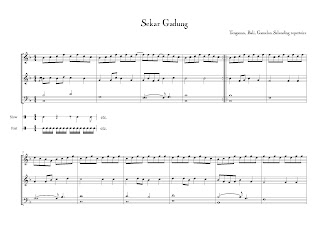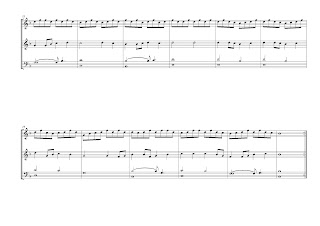David Toub has a nice post on the advantages of composing an open score. He was fortunate to have a piece played by the Diverse Instrument Ensemble (aka D.I.E.) at CSU Fullerton. D.I.E. is an innovation of Prof. Lloyd Rodgers (a fine composer and a teacher), and something that every self-respecting music department should have -- an on-going ensemble without a fixed instrumentation as an opportunity to get ears and hands into a wide range of music -- early music, new music, all the stuff in-between, and perhaps even a glance at non-western traditions, with the emphasis on experimenting as a group with ways to make the music come off the page rather than replicating a received performance tradition. In other words, the exact opposite of the usual band, orchestra, and choir.
A while back, I made a suggestion that there should be an "Online Book of Consort Lesson", a page with links to scores with open instrumentation. Let's make this happen.
Added: To get things going, here's a transcription from the Salunding (archaic iron gamelan) repertoire of the Bali Aga village of Tenganan. Play the whole thing several times, a bit slower with the upper cengceng (a nest of small cymbals -- try substituting a closed high hat) part, a bit livelier with the lower part:
A while back, I made a suggestion that there should be an "Online Book of Consort Lesson", a page with links to scores with open instrumentation. Let's make this happen.
Added: To get things going, here's a transcription from the Salunding (archaic iron gamelan) repertoire of the Bali Aga village of Tenganan. Play the whole thing several times, a bit slower with the upper cengceng (a nest of small cymbals -- try substituting a closed high hat) part, a bit livelier with the lower part:


1 comment:
Daniel, thanks for the kind comments! I think open instrumentation can be a great way to go. I'll be interested in seeing if such works get more traction among performers.
Post a Comment